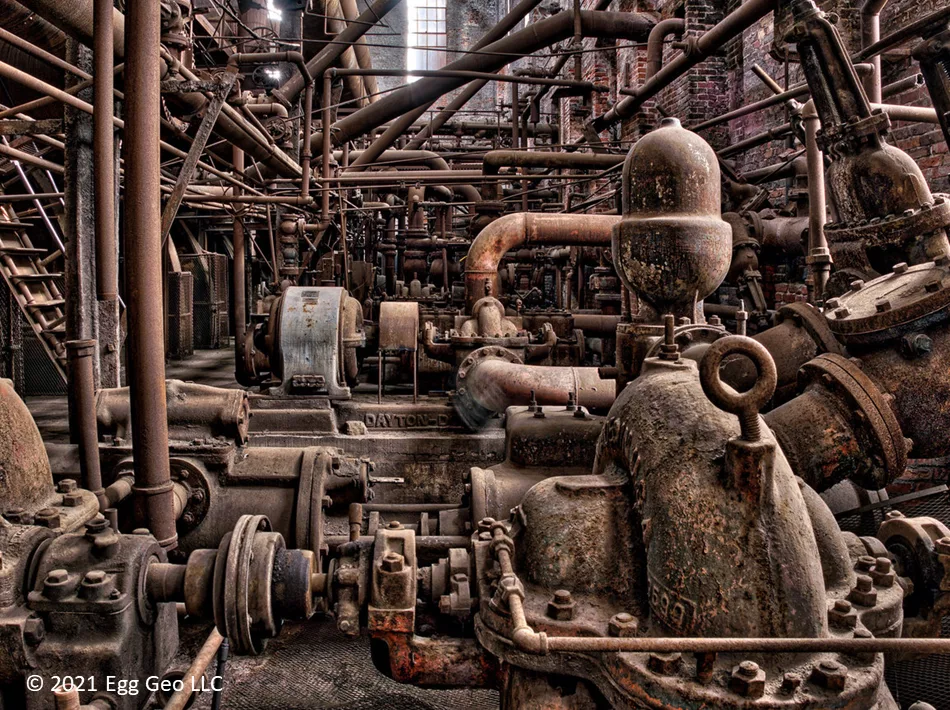Water infrastructure under our streets and in our buildings is useful for a lot more than potable water and sanitary sewer. Water is necessary to sustain life, but it’s also the best conductor of thermal energy available. Moving BTUs around a building or a city hydronically (a system of heating or cooling that involves transfer of heat by a circulating water-based fluid in a closed piping system) is the most efficient and effective way to move thermal energy.
Consider all the drinking water and wastewater moving through our city streets. Every gallon of moving water — whether its storm, potable or wastewater — is an opportunity to exchange heat; to move heat into, or out of, our buildings for the purpose of heating and cooling. This is part of new infrastructure going in to complement our existing infrastructure. This is the thermal energy network (Figure 2).

We are talking about water-energy. The movement of water to transfer energy in the form of BTUs is indeed one of the most basic and simple uses of water in every form. It has been safely done for generations, and is the most efficient form of heating and cooling energy transfer.
As I was writing this column, I got a call from John Murphy, international representative of the United Association, about the uptake in thermal energy networks. John is pleased that his plumbers will not have to be retrained to work on windmills and PV panels. Geothermal HVAC systems are fundamentally hydronic, and John wants to ensure his union plumbers are trained and ready to pipe BTUs in the form of thermal energy networks.
A federal law cited in the Energy Policy Act of 1992 permits drinking water energy exchange. The legislation uses language such as “allowing the installation of geothermal heat pumps … to permit public and private water recipients to utilize the flow of water from, and back into, public and private water mains for the purpose of providing sufficient water supply for the operation of residential and commercial geothermal heat pumps.” (Chu, 1992, https://bit.ly/2L6O7JH.)
In New York City, one of the bills currently being heard in council chambers involves hydroelectric power using the city's aqueducts. This is the same fundamentally as using the city's aqueducts to transfer thermal energy. Actually, the conduit hydropower system is more intrusive, as the impellers are in the water stream. In the case of thermal energy, the drinking water is isolated by a double-wall titanium heat exchanger.
Geothermal exchange is generally known to be a technology that exchanges heat with the earth through closed-loop boreholes. While this is the most basic and fundamental approach to geothermal heating and cooling, a broad-spectrum approach involving all the authorities having jurisdiction and provides a symbiotic relationship between the utilities that improves the function of each and every part.
Drinking water energy, along with other fluid exchange, provides real solutions that play a vital part in converting our building stock over to heat pumps, notes an Institute for Local Self-Reliance October 2020 report titled, “Could Existing Water Pipes Replace Dirty Energy Utilities?” by Lilli Ambort and John Farrell.
In addition to drinking water energy, there are five other types of fluid exchange in dense urban environments that may be used to help heat and cool buildings (Figure 3):

- Effluent water thermal exchange;
- Wastewater thermal exchange;
- Infrastructure dewatering thermal exchange (low-lying coastal communities, subways and tunnels, locks and dams, etc.);
- Surface water thermal exchange;
- Conduit hydropower and thermal exchange;
- Drinking water thermal exchange.
Hydropower is energy in moving water, such as oceans, rivers and waterfalls. Hydroelectric energy is generated by converting kinetic energy from water into electrical energy.
To harness this power, enormous dams are built to extract, maximize and manage the energy generation. Handling these massive volumes of fluid should always be coupled with thermal energy exchange when possible, such as when these hydroelectric stations are near large city centers.
Surface water thermal exchange includes rivers, ponds, lakes, aqueducts and water features. Surface water exchange can consist of plate exchangers or pipe in the water, water extraction and rejection, or any variations of submerged exchangers.
The UK Department of Energy and Climate Change commissioned BuroHappold to study surface water exchange potential (Figure 4). The study showed 6 GW of thermal capacity, enough to heat and cool 7 million homes. Though the United States has no such research, it is reasonable to suppose U.S. capacity would be greater.

Infrastructure dewatering thermal exchange includes ongoing efforts for low lying cities and infrastructure, subways and conduits that need to be kept dry and, of course the need for current and future efforts to handle ocean rise. Where relative sea level rise occurs, it amplifies near-term vulnerability to storm surge and increases long-term flood and inundation risk (EPA, 2017).
Wastewater thermal exchange
We spend money to heat water that gets wastefully dumped down the drain. A wastewater recovery exchanger system is installed where wastewater leaves the building, extracting and transferring heat to a holding tank that feeds the domestic hot water system (Figure 5). By preheating the water provided to the hot water tank, a tremendous amount of energy, money and greenhouse gas is saved.

In cooling-dominant situations, systems such as Piranha can also simultaneously dump heat into wastewater to reduce air-conditioning loads.
Effluent water thermal exchange opportunities exist in almost every village and community in America. According to the U.S. Environmental Protection Agency, in its “Primer for Municipal Wastewater Treatment Systems” report (EPA, https://bit.ly/3aOuTna), collecting and treating wastewater is the most common form of pollution control in the United States, consisting of a system of sewers and wastewater treatment plants.
The sewers collect municipal wastewater from homes, businesses and industrial buildings and deliver it to facilities for treatment before being discharged to water bodies or land or reused. Most of this effluent is discharged to surface water rivers or injected into wells. Either way, thermal heat exchange with effluent represents a major opportunity for heat exchange in the communities in which they exist.
Many of the earliest sewer systems were combined sewers, designed to collect both sanitary wastewater and stormwater runoff in a single system, notes the U.S. Environmental Protection Agency. These combined sewer systems were designed to provide storm drainage from streets and roofs to prevent flooding in cities.
Later, lines were added to carry domestic wastewater away from homes and businesses. Early sanitarians thought these combined systems provided adequate health protection. We now know that the overflows designed to release excess flow during rains also release pathogens and other pollutants (EPA, 2017, http://bit.ly/2WUQNgo).
An urgent effort is ongoing to replacing combined systems — an effort that, with little modification, would afford heat exchange to every building served. Stockholm has been applying this effectively (Figure 6).

Elimination cooling towers
Here is some follow up information on the Energy Policy Law shared at the beginning of the column:
“42 USC 13551 SEC. 3013. GEOTHERMAL HEAT PUMPS.
“The Secretary Shall—
“Encourage States, municipalities, counties, and townships to consider allowing the installation of geothermal heat pumps, and, where applicable, and consistent with public health and safety, to permit public and private water recipients to utilize the flow of water from, and back into, public and private water mains for the purpose of providing sufficient water supply for the operation of residential and commercial geothermal heat pumps; and not discourage any local authority which allows the use of geothermal heat pumps from—
“a. Inspecting, at any reasonable time, geothermal heat pump connections to the water system to ensure the exclusive use of the public or private water supply to the geothermal heat pump system; and
“b. Requiring that geothermal heat pump systems be designed and installed in a manner that eliminates any risk of contamination to the public water supply.”
As we see in Figure 7, drinking water thermal exchange will handle the heating and cooling needs of the Amalgamated campus, as well as several public schools when it is approved.

Also, the elimination of cooling towers is accomplished. Cooling towers are a source of Legionnaires' disease; they are costly to maintain and a health and safety issue in NYC and beyond. Cooling towers are eliminated or reduced when coupled to geothermal HVAC systems (clean heating and cooling).
So far, lack of communication between governing authorities and legislative hurdles have been obstacles to implementation of clean heating and cooling technologies needed to decarbonize buildings.
A qualified task force that can operate with the purpose to implement simple, yet essential changes and cooperation between infrastructure authorities would accelerate decarbonization and energy efficiency efforts throughout the city, state and even federal government.
Drinking water energy, along with other fluid exchange, provides real solutions that play a vital part in converting our building stock over to heat pumps. Our nations plumbers are front and center in this effort.





